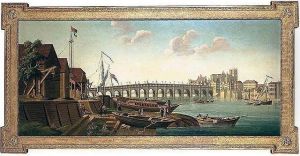Carl Traugott Fechelm Paintings
Carl Traugott Fechhelm was a German engraver and painter, born in 1763 in Dresden, Saxony. His career unfolded during a period rich in artistic evolution, marked by the transition from Rococo to Neoclassicism in European art. Fechhelm's contributions, although not as widely recognized as those of his contemporaries, played a significant role in the artistic landscape of his time, especially within the realm of engraving and miniature painting.
Fechhelm received his artistic training at the Dresden Academy of Fine Arts, an institution renowned for its rigorous curriculum and emphasis on traditional techniques. This education provided him with a solid foundation in the fundamentals of drawing, painting, and engraving, all of which were essential skills for an artist of his era. He was particularly noted for his skill in copperplate engraving, a technique that demands precision and patience, and through which he was able to achieve remarkable detail and subtlety in his works.
Throughout his career, Fechhelm's artistic output was diverse, encompassing not only engravings but also miniature portraits, a genre that was immensely popular in the late 18th and early 19th centuries. His portraits were celebrated for their delicacy and accuracy, capturing the nuances of facial expressions and the textures of fabrics with finesse. Fechhelm's work reflects the broader trends of his time, including an interest in realism and an emphasis on the individual, characteristics that were at the heart of Neoclassical art.
Despite his talent and contributions to the arts, Carl Traugott Fechhelm did not achieve the same level of fame as some of his contemporaries. His career was relatively short, as he died in 1805 at the age of 42. Nevertheless, his works remain as testaments to the skill and artistic sensibilities of a period that was pivotal in shaping the course of European art. Fechhelm's legacy, though modest, is preserved in collections and archives that value the depth and detail of his engravings and portraits, ensuring that his contributions to the world of art continue to be appreciated.

